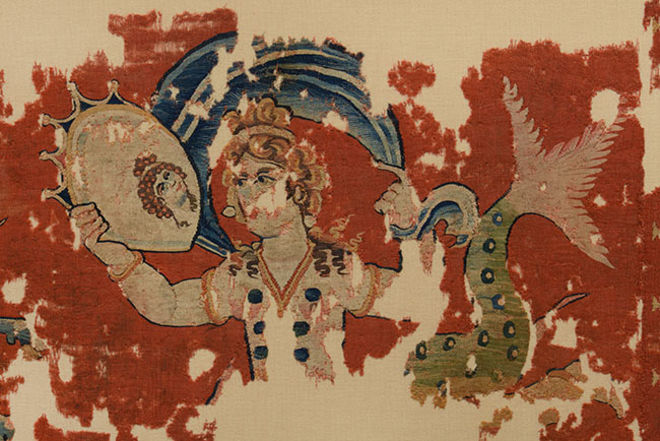










| April 2025 | ||||||
|---|---|---|---|---|---|---|
| Su | Mo | Tu | We | Th | Fr | Sa |
1 | 2 | 3 | 4 | 5 | ||
6 | 7 | 8 | 9 | 10 | 11 | 12 |
13 | 14 | 15 | 16 | 17 | 18 | 19 |
20 | 21 | 22 | 23 | 24 | 25 | 26 |
27 | 28 | 29 | 30 | |||


38 West 86th St.
New York, NY 10024
212.501.3000
admissions@bgc.bard.edu
18 West 86th St.
New York, NY 10024
212.501.3023
gallery@bgc.bard.edu
BGC Gallery is currently closed.
38 West 86th St.
New York, NY 10024
212.501.3000
admissions@bgc.bard.edu
18 West 86th St.
New York, NY 10024
212.501.3023
gallery@bgc.bard.edu
BGC Gallery is currently closed.
April 28–29, 2022

Covering, protecting, and adorning the body count among the most fundamental of human concerns, at once conveying aspects of an individual’s persona while also situating a person within a given social context. Wearable adornment encompasses materials fashioned by human hands (like fabric, metalwork, or even animal bones) and modifications to the body itself (such as tattoos, cosmetics, or hairstyles), which beautify the body while simultaneously conveying social, political, and protective functions and meanings. The wearable is thus the most representational and at the same time most intimate product of material culture.
This conference seeks to expand our current understanding of the wearable in the Middle Ages. Current scholarship on the topic in Byzantine, western medieval, Eurasian art, as well as Islamic traditions tends to encompass clothing and jewelry, and is frequently medium-specific, with minimal regard to the interrelatedness of different aspects of appearance. On the one hand, work on medieval textiles has tended to approach questions of identity, consumption, and appearance by comparing textual sources and visual depictions with surviving textiles. The study of medieval jewelry, on the other hand, largely focuses on the classification and attribution of precious metal pieces from excavations and museum collections, as scholars make sense of pieces long removed from the bodies they once adorned. Tattoos, prosthetics, cosmetics and headgear are almost entirely absent in our understandings of medieval dress practices. This separation was not always so, however, and indeed nineteenth-century art historians such as Gottfried Semper integrated all aspects of bodily adornment in their considerations of the nature of ornamentation and surface decoration.
Abstracts available here.
1:30 pm
Deborah Krohn
Bard Graduate Center
Welcome
Elizabeth Dospel Williams
Dumbarton Oaks Research Library and Collection
Ittai Weinryb
Bard Graduate Center
Introduction
2 pm
Alicia Walker
Bryn Mawr College
“Christian Bodies Clothed in Pagan Bodies: The Implications of Greco-Roman Mythological Imagery on Early Byzantine Items of Dress and Adornment”
Zvezdana Dode
Nasledie Institute
“The Robe of Honor and the Belt of Submission in the Mongolian Imperial Culture”
Q&A and Discussion
3:30 pm
Coffee Break
4 pm
Eiren Shea
Grinnell College
“Clothing the Khatun: Mongol Women’s Dress and Political Power”
Juliane von Fircks
Friedrich Schiller University Jena
“To Adorn the Dead Body: The Representation of the Deceased Prince in and outside the Grave (13th–15th Centuries)”
Cecily J. Hilsdale
McGill University
“Crowns and the Situating of Authority”
Q&A and Discussion
Friday, April 29, 10 am–5 pm
10 am
Cynthia Hahn
Hunter College and the Graduate Center, CUNY
“The Medieval ‘Safety’ Pin”
Antje Bosselmann-Ruickbie
University of Gießen
“Putting the Empress’s Neck on the Line: The Materiality of Imperial Neck Ornamentation in Byzantium”
Q&A and Discussion
12 pm
Lunch Break
1 pm
Sarah Laursen
Harvard Art Museums
“Out of Place and Out of Sight: Ornaments from Medieval China in American Collections”
Meredyth Lynn Winter
Colgate University; Philadelphia Museum of Art
“Dressing for Paradise: A Consideration of Designs & Materials Befitting Islamic Burial Clothing”
Q&A and Discussion
2:30 pm
Coffee Break
3 pm
Ashley Elizabeth Jones
University of Florida
“Wearable Matter”
Ivan Drpić
University of Pennsylvania
“The Burdened Body: Devotional Jewelry and the Weight of the Sacred”
Q&A and Discussion
4:30 pm
Conclusion
5 pm
Reception
38 West 86th St.
New York, NY 10024
212.501.3000
admissions@bgc.bard.edu
18 West 86th St.
New York, NY 10024
212.501.3023
gallery@bgc.bard.edu
BGC Gallery is currently closed.

